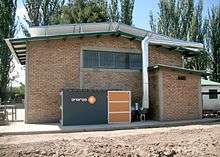Solar dryer
Solar dryers are devices that use solar energy to dry substances, especially food. There are two general types of solar dryers: Direct and indirect.[1]
Direct

Direct solar dryers expose the substance to be dehydrated to direct sunlight. Historically, food and clothing was dried in the sun by using lines, or laying the items on rocks or on top of tents.[2] In Mongolia cheese and meat are still traditionally dried using the top of the ger (tent) as a solar dryer.[3] In these systems the solar drying is assisted by the movement of the air (wind) that removes the more saturated air away from the items being dried.[2] More recently, complex drying racks[4] and solar tents[5][6] were constructed as solar dryers.
One modern type of solar dryer has a black absorbing surface which collects the light and converts it to heat; the substance to be dried is placed directly on this surface. These driers may have enclosures, glass covers and/or vents to in order to increase efficiency.[7]
Indirect

In indirect solar dryers, the black surface heats incoming air, rather than directly heating the substance to be dried. This heated air is then passed over the substance to be dried and exits upwards often through a chimney, taking moisture released from the substance with it.[2] They can be very simple, just a tilted cold frame with black cloth[8] to an insulated brick building with active ventilation and a back-up heating system.[9] One of the advantages of the indirect system is that it is easier to protect the food, or other substance, from contamination whether wind-blown or by birds, insects, or animals.[2][9] Also, direct sun can chemically alter some foods making them less appetizing.[2][9]
See also
References
- ↑ Norton, Brian (2013). Harnessing Solar Heat. Springer. ISBN 978-94-007-7275-5.
- 1 2 3 4 5 Heinz, Gunter & Hautzinger, Peter (2007). "Meat drying". Meat processing technology for small- to medium-scale producers. RAP Publication 2007/20. Bangkok, Thailand: Regional Office for Asia and the Pacific, Food and Agriculture Organization of the United Nations. ISBN 978-974-7946-99-4. Archived from the original on 23 May 2010.
- ↑ Oyunbayar, N. "Mongolian Food: Meat, milk and Mongolia". Mongoluls.Net. Archived from the original on 5 April 2005.
- ↑ Shaffer, Marcella (1999). "Solar Food Drying". Backwoods Home Magazine. No. 58. Archived from the original on 16 August 2000.
- ↑ Trim, D. S. & Curran, C. A. (1983). "Solar dryers". Comparative Study of Solar and Sun Drying of Fish in Ecuator. London: Tropical Products Institute. ISBN 978-0-85954-158-9. Archived from the original on 2 September 2015.
- ↑ Olokor, Julius Oghenekaro & Omojowo, Funso Samuel (2009). "Adaptation And Improvement Of A Simple Solar Tent Dryer To Enhance Fish Drying" (PDF). Nature and Science. 7 (10): 18–24. Archived (PDF) from the original on 2 September 2015.
- ↑ Fodor, Eben (2006). "Build a Solar Food Dehydrator" (PDF). Mother Earth News. Vol. 2006 no. August/September. pp. 66–70. Archived from the original on 2 September 2015.
- ↑ Robishaw, Sue (1999). "Drying Food with the Sun". Countryside & Small Stock Journal. 1999 (July/August). Archived from the original on 2 September 2015.
- 1 2 3 Weiss, Werner & Buchinger, Josef (2001). "Solar Drying" (PDF). Austrian Development Cooperation and Institute for Sustainable Technologies (AEE INTEC). Archived (PDF) from the original on 26 May 2012.
External links
- "Links to articles, photos, and other sites related to solar food drying". SunWorks Technologies LLC. 2014. Archived from the original on 2 September 2015.